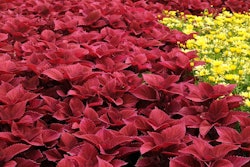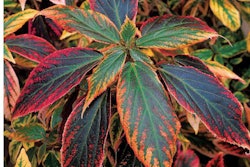A year after a historic flood, the gardens at the Nashville’s Gaylord Opryland Resort are more vibrant than ever.
In the first two days of May 2010, flooding caused by torrential rains devastated portions of Tennessee, Kentucky and Mississippi. In Nashville, the Cumberland River crested at levels not seen since 1937, flooding the city.
After the storm, Hollis Malone, horticulture manager of the Gaylord Opryland Resort & Convention Center, entered the Cascades Atrium of the resort and says he felt sick.
Eight feet of water from the Cumberland filled the building’s once-opulent, 9-acre indoor botanical gardens. “It was unbelievable. Most of the plants were underwater; tables were floating around. You could smell the diesel from the flooded generators. All of our hard work had been washed away,” Malone says.
The glass atriums at the Opryland Resort provide ample light for plants and trees to thrive. Many bloom all year.
But Malone, a self-proclaimed optimist, didn’t mourn for long. In conjunction with teams of remediation experts, he and his crew immediately went to work to repair the damage and revive the indoor gardens, which help attract more than 1 million visitors annually.
Luckily, the outdoor grounds of the hotel were more easily repaired. Within a day, excess water and mud were pushed from the lawn by brooms attached to the crews’ lawnmowers, and trees and plants along the property were power washed with non-foaming soap to remove the diesel.
Few exterior plants were lost, but some still bear faint brown rings around their trunks and foliage, war wounds indicating the high water mark of the flood.
Key advice Malone offers any landscape professional facing clean up after a natural disaster: Give your plants a chance to rebound before pulling them up, especially if they are natives because they are hardier. “Things really do survive if you give them a chance,” he says.
He also says it’s essential to stay organized, be mindful of the emotional toll disasters take on your customers and staff, and focus on the potential of improving the property.
Whether you are dealing with the aftermath of a flood, hurricane, tornado or blizzard, most landscape professionals will face some sort of storm damage during their careers. It’s important to be prepared and keep your cool.
“As bad as this tragedy was, I have to look at the good that came of it. The garden now has more rare and unusual plants than before the flood. We added so many new varieties of plants to the gardens, stuff that wasn’t available previously,” he says.
Coming back to life
The cleanup and restoration to the interior gardens required five months. Nineteen employees worked 10 hour days, seven days a week. At times, the interior temperature reached 100 degrees, and the atriums were blanketed by fog because the air conditioning was out of commission. But the staff persevered.
This aerial shot, taken just after the flood, shows he resort property submerged in water.
“One of our supervisors’ houses was under water, but she was here working every day. It was an emotional time for everyone,” Malone says.
For five days, thousands of gallons of water were pumped from the hotel. A remediation company from Fort Worth, Texas, advised Malone to remove all of the soil and trees from the gardens.
He agreed to replace the soil, which still reeked from the floodwaters and contaminants, but refused to pull out all the plants he had nurtured for so many years.
Like the exterior plants, they were pressure washed. Many survived, including a 70-foot-tall sugar palm that Malone bought from a rare plant collector in Miami in 1986.
“As bad as this tragedy was, I have to look at the good that came of it.”
He has stories for all of the trees and plants, speaking of them like they are old friends or his children. But the palms are his favorite. Today, the gardens house 63 varieties of palms, an oasis of tropical plants, a 45-foot waterfall, koi pond and a river that winds through the resort for half a mile.
Better than before
During the restoration, the crew stayed in communication with radios and cell phones, working the first two weeks out of their trucks, then from portable offices placed in front of the resort. They ate lunch across the street at the Radisson Hotel, another Gaylord property.
“It was like redecorating a house. We had a lot of fun. We were optimistic. It is better than it was before.”
After the water and contaminated soil were removed, a local contractor pumped 3,000 cubic feet of new soil into the gardens, stretching the pump line more than 800 feet from the doorway.
Crew members clean the koi pond at least once a week to keep the water clear and fish healthy.
The soil was shipped from Florida, a special mix of cypress and pin bark, peat moss and sand. Blowing the soil into the gardens saved valuable time and energy.
“He [the contractor] saved us a fortune on labor. Otherwise, we would have had to bring the bags, weighing 65 to 70 pounds each, by hand,” Malone says. “It saved us physically, as well as a lot of time that we were able to use to concentrate on planting.”
The crew planted 14 tractor-trailer loads of tropical plants, most 4 to 5 feet tall. Many of the plants were shipped from Florida where Malone called on nurseries he had worked with for more than 20 years.
Besides enhancing the gardens with new plants, the restoration also allowed the crews to tackle major maintenance needed to portions of the gardens that were not damaged, which is not an easy task when the hotel is open for business.
“It was like redecorating a house. We had a lot of fun. We were optimistic. It’s better than it was before,” he says.
Fast forward
Now, the flood is a distant memory, as the 20-member interior horticulture staff bustles around the resort caring for the lavish gardens. Most of the maintenance, such as pruning trees, is done in small segments during off hours, so patrons are not disturbed. However, the staff is encouraged to interact with guests who typically are curious about the foliage and flowers. In fact, trees and plants are not labeled so as to encourage visitors to ask questions.
The gardens are broken into three collections, the Garden Conservatory, which features 10,000 tropical plants representing more than 215 species. This group includes ficus trees, banana trees, palms and a sampling of miniature orange trees.
“We went to Florida in 1982 and bought most of the trees a year ahead of opening,” Malone says. “In some cases, we actually took cuttings and had a Florida nursery grow the plants especially for us.”
The Cascades Atrium includes more than 8,200 tropical ornamental plants, representing 449 species, as well as the koi pond, fountains and a waterfall. Many of the plants bloom year-round.
The Delta boasts an indoor river and subtropical trees and plants including magnolias, gardenias and camellias.
A drip irrigation system ensures plantings receive appropriate water, and soaring glass atriums provide ample natural light.
An elaborate climate-control system keeps the indoor temperature 68 to 72 degrees year-round and provides the necessary air-exchange. The biggest part of maintaining the gardens: dusting the plant leaves.
This time of year, the hotel and grounds are adorned with more than 2 million twinkling lights, as well as other Christmas decorations and poinsettias. The festivities and holiday décor have become a grand tradition for the hotel. This year, they are even more special.
“The gardens are as pretty as they have ever been in my 27 years of celebrating ‘A Country Christmas’ at the hotel,” Malone says.
“It shows how we all pulled together with passion, perseverance and pride to not only restore the hotel to its original splendor, but to make it even more incredible for our guests.”
Adding Storm Cleanup to Your Services
As part of Jerry Day’s normal routine, he keeps an eye on the Weather Channel tracking storms. In the summer, it’s hurricanes. In the winter, he watches for ice storms. Not to mention tornadoes and other severe weather.
Day and his crews have seen it all. They are landscapers specializing in tree care for Arbor Masters in Kansas City with satellite offices in Wichita, Oklahoma City, Tulsa, Dallas, Ocala and Tampa, Florida. Besides routine tree care and other landscaping services, Arbor Masters has a dedicated storm service division, deploying crews to disasters all across the country.
They are not storm chasers, Day is quick to point out, but are hired by municipalities, the federal government, other landscapers and HIM, a company that provides claims support to various insurers for tree damage and landscape loss.
When one or more of his crews deploys to a disaster, they travel quickly, sometimes through the night, while other staff members in the office take care of logistics such as where the crews will reside during the cleanup. Trailers are often installed at the disaster site to serve as offices. The crews travel with their own equipment, but occasionally rent what’s needed in the area, as well.
“It’s a dangerous business. Our people have been doing it every day for years and years. If you needed a concrete driveway poured, you wouldn’t call someone in the tree-care business. This is the same thing. For these types of jobs, you need an expert,” Day says.
While you may not be a certified arborist, there may be opportunities to add storm services to your business. Day suggests:
• Become ISA certified. The International Society of Arboriculture program offers six credentials that take you from the ground to the canopy and everywhere in between: www.isa-arbor. com/certification/index.aspx
• Network with other landscapers who handle storm cleanup and restoration through professional trade organizations and conferences. They may be able to provide leads or use your company on jobs they have secured.
• Offer storm cleanup to your existing customers. Even if you aren’t a certified arborist, you can clean up debris and offer new plants.
“If you connect with the right people, [storm work] can be a revenue source for your company,” Day says. “But you shouldn’t depend on it because we don’t know year to year what disaster will take place.”











